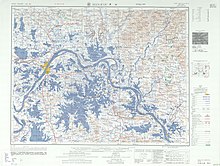Ch'i-ch'un
Jump to navigation
Jump to search
English[edit]

Etymology[edit]
From Mandarin 蘄春/蕲春 (Qíchūn) Wade–Giles romanization: Chʻi²-chʻun¹.
Proper noun[edit]
Ch'i-ch'un
- Alternative form of Qichun
- 1967, Philip Yampolsky, The Platform Sutra of the Sixth Patriarch[1], New York: Columbia University Press, →ISBN, →LCCN, →OCLC, →OL, page 3:
- Hung-jen’s temple is frequently referred to as Huang-mei, after the district in which it was located. It is in present-day Ch’i-ch’un in Hupeh.
- 1971, Charles Price Ridley, Paul H. B. Godwin, Dennis J. Doolin, The Making of a Model Citizen in Communist China[2], Stanford, Cali.: Hoover Institution Press, →ISBN, →LCCN, →OCLC, →OL, page 340:
- Li Shih-chen was one of our nation's great doctors and pharmacologists. He was a native of Ch'i-ch'un in Hupeh during the Ming Dynasty.
- 1978, Arthur F. Wright, The Sui Dynasty[3], New York: Alfred A. Knopf, →ISBN, →LCCN, →OCLC, page 143:
- General Wang's army was based at Ch'i-ch'un, in modern Hupeh, just north of the Yangtze, some hundred miles down river from the next and more important point in the Sui deployment, Han-k'ou, where the Han River enters the Yangtze.
- 1988 December, Wen-kai (龔文凱) Kung, “The Official Biography of Tu Mu (803-852) in the Old T'ang History”, in Chinese Culture: A Quarterly Review[4], volume XXIX, number 4, Taipei: Chinese Culture University Press, →ISSN, →OCLC, page 95:
- Tu Ts'ao was appointed Prefect of Ch'i-chou 蘄州 (present-day Ch'i-ch'un 蘄春 in Hu-pei Province), and Tu Mu and Yi accompanied Ts'ao to Ch'i-chou, and then Tu Mu returned to the capital.
- 1991, Peng-Yoke Ho, “Ch’in Chiu-shao”, in Biographical Dictionary of Mathematicians: Reference Biographies from the Dictionary of Scientific Biography[5], volume 1, →ISBN, →LCCN, →OCLC, page 481, column 2:
- The Mongols invaded Szechuan in 1236, and Ch’in fled to the east, where he first became a vice-administrator (t’ung-p’an) in Ch’i-chou prefecture (now Ch’i-ch’un in Hupeh province) and then governor of Ho-chou (now Ho-hsien in Anhwei province).
- 1992, Chun-shu Chang, Hsueh-lun Chang, “Crisis and Revolution in the Ming-Ch'ing Intellectual World: Li Yü's World in Historical Perspective”, in Crisis and Transformation in Seventeenth-Century China: Society, Culture, and Modernity in Li Yü's World[6], Paperback edition, Ann Arbor: University of Michigan Press, published 1998, →ISBN, →LCCN, →OCLC, pages 285–286:
- The author of The Compendium of Materia Medica was Li Shih-chen (1518-93), a pioneering scholar in the field of medicinal research in the late Ming. A native of Ch’i-chou in Hukuang (modern Ch’i-ch’un in Hupei), Li Shih-chen achieved the first-degree hsiu-ts'ai in 1531, but gave up obtaining the second-degree chü-jen after three unsuccessful attempts between 1534 and 1540.
- 2000, Sheau-yueh J. (趙賀筱岳) Chao, “Genealogy of Chinese Surnames”, in 尋根溯源中國人的姓氏 [In Search of Your Asian Roots: Genealogical Research on Chinese Surnames][7], number 50, Clearfield Company, Inc., →ISBN, →OCLC, page 29[8]:
- According to Hsing yüan 姓苑, the surname Ch'i 蘄 derived from the place name Ch'i-ch'un 蘄春, located in the present Ch'i-chun hsien 蘄春縣, Hu-pei 湖北 province.
- For more quotations using this term, see Citations:Ch'i-ch'un.
Translations[edit]
Qichun — see Qichun
Further reading[edit]
- Leon E. Seltzer, editor (1952), “Kichun or Ch’i-ch’un”, in The Columbia Lippincott Gazetteer of the World[9], Morningside Heights, NY: Columbia University Press, →OCLC, page 942, column 3